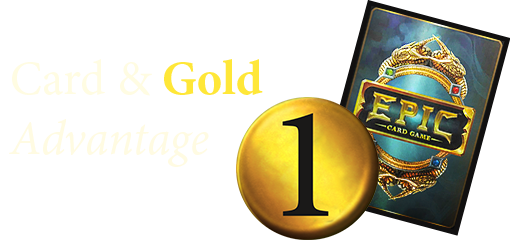
The engines of Epic
Gold and draw are the most powerful resources in all of Epic. Without draw, you could only play 5 cards per game. Without gold, you could only play free ⓪ cards. Without either, even a deck running as many silvers as possible will only be able to play about two to three cards per game. So these are completely essential parts of Epic—the game doesn’t even work without them. Therefore, wouldn’t you like to maximize them as much as possible? I think most Epic players would’ve been on board if I said that from the start. But it’s crucial to outline exactly how powerful these effects are. Let’s go over some general logic.
If it’s clear that you need to play cards in this game but you can only play one powerful ① card per turn—then gold should be directly equated with actions. This is essentially a very limited action economy pool. Cards, would be equated with longevity and options—where both are essentially on the same axis, such that reducing your longevity (by playing or discarding) also reduces your options available at any given time. So essentially, both of those just describe your options over a given period of time.
Maintaining as many options as possible for as long as possible, should be a goal. Likewise, getting as many actions as possible should also be a goal. If you were to miss an action on your opponent’s turn but they didn’t, then you would be in the hole a ①. You used one less action, affected the game state less by the equivalent of a single powerful card, went behind in turn order by one. If you run out of cards, this is exactly what happens.
Gold
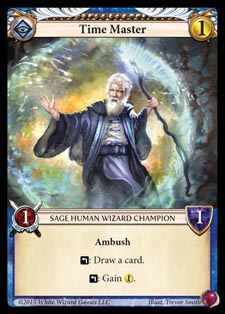
Let’s get down to how to get the most out of your ①. We should start at the very basics, which is how to keep playing ①① per round. A round is two turns, one of yours and one of your opponent’s. You’ll get ① per turn each turn and need to spend it as optimally as possible. To play optimally, the order in which each player uses a card matters. Sometimes there’s merit to going first, but almost always the game is most impacted by the player who went second. For example, just consider spot-removal and board wipes after a blitz champion was slapped down and attacked. Also, if you wanted to use your event’s “draw two” ability, you would want to wait very late so your opponent doesn’t know if you have response that turn to any crazy stunt they pull.
Now that you can see the innate merits of spending second, it’s clear that we need a gold engine. This doesn’t really exist outside of one illegal promo—Time Master. Instead, we’ll have to scrape by with clever play to gain more gold indirectly. This won’t be about us adding gold to our pool, though Brachiosaurus can do it, but instead about making the opponent lose gold. What happens if you pay ①, play a card, and then it doesn’t really affect the game? You essentially lose ①. What about if you pay ①, then the opponent uses a ⓪ to get rid of it? Well, that’s also like losing ①. Okay and in a third scenario: you pay ①① for two different cards, the opponent pays ① to remove the effect of both on the game. That is also like losing ①. Let’s take a look at these scenarios in real examples:
- Your opponent pays ① to play a targetable champion. You expend your existing Time Bender to bounce it to their hand. You paid no gold or cards and removed their ① for turn.
- Your opponent pays ① to play a targetable, breakable champion with 5 or less defense. You play your Lightning Strike for ⓪ from hand. You paid no gold but one card and removed their ① for turn.
- Your opponent pays ① to ambush in a champion on your turn, then pays ① to play a champion on their own turn. You play Inheritance of the Meek; assuming they are banishable, you paid ① and one card to remove ①① and two cards.
And here is how each scenario could’ve gone in the opponent’s favor:
- Your opponent pays ① to play Bitten and breaks your existing Time Bender. You both paid ① and lost one card. Though, you may have gotten use from it already, but consider just this scenario.
- Your opponent pays ① and plays a champion with any of the following: 6 or more defense, untargetable, unbreakable on your turn. You now cannot play Lightning Strike.
- Your opponent plays more conservatively and chooses to get one champion going at a time, until you finally commit something. As long as they never stay more than one champion ahead of you, your Inheritance of the Meek can never give you either type of advantage. Any unbanishable champions they play will be considered free.

So it would seem from this list that the easiest way to avoid an opponent getting gold advantage, other than just not misplaying, would be to use untargetable, unbreakable, and unbanishable champions. This makes sense as these champions are already great for resisting removal. Another esoteric way to get gold advantage not listed here is an opponent playing a draw two effect while you have two Thought Pluckers available to hit. There are countless examples of how to gain gold advantage. The ones with the least effort (first scenario of having an active champion that is removal) generally have the most risk: an opponent can simply change their play to use removal and simplify the game. This also works in reverse, where if your opponent takes a bigger risk by having more champions, it becomes easier for you to gain advantage. Using silvers to gain gold advantage tends to be much harder, but forcing these situations is extremely beneficial to you.
Gold advantage is often best accrued over time using ally abilities. Since these trigger when you pay ① of the same alignment from hand, they require careful deckbuilding and giving up many excellent options. However, they grant you a cascade of abilities the moment you begin to pay ①. Let’s consider for example, a Wild deck, where the field is one of Fire Shaman, Fire Spirit, Wurm Hatchling, or Smash and Burn in the discard.
- Fire Shaman: Dealing 3 damage to a target is approximaely 1/3 the effect of Flame Strike. Ally 3 times to get gold advantage.
- Fire Spirit: Dealing 4 damage to a champion is 1/3 of Chomp! Ally 3 times to get gold advantage (since you keep the champion). Though this one is a rough case where Chomp! can do the damage all at once to a single target.
- Wurm Hatchling: Grows by +2/+2 per turn. Ally 7 times to get gold advantage (by making it a Burrowing Wurm). Not a very viable one.
- Smash and Burn: You only get one shot at 6 damage to a target champion. However, this follows the path of Lightning Strike as above. Ally once to gain gold advantage.
Just from this example, you can see that ally abilities are viable ways to give gold advantage. When you start with a silver, or anything in your discard, you need fewer activations to make a gold appear from thin air. In the case of Fire Shaman, you can get a total of 9 damage to up to three targets (which is actually better than Flame Strike) in 3 ally activations. That’s essentially the turn you put it into play, your opponent’s next turn, then your turn assuming it survives. Getting a Flame Strike out of thin air is not something to simply be discounted; it has a major impact on the game of giving you what essentially comes down to a free turn. In this case, it’s a free turn immediately because you played no additional cards but got the game effect of an additional gold. Just like with our original examples, (most) ally abilities carry risk since they are committed to the field.
Cards
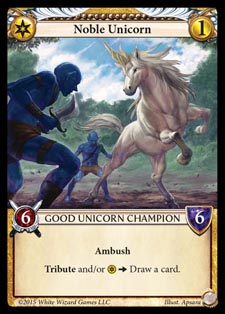
Now that we understand how to gain free virtual gold, let’s talk about cards. Just about every gaming blog under the sun will do an article on card advantage. If you’re a veteran of TCGs, you can skip this paragraph. In card games, you are often faced with the problem of running out of options which are your cards. This will occur if you’re not a sharp custodian of your hand and field. Opponents are going to try and remove your cards (your options) and keep their own. This gives them an abstract advantage over you: their options and longevity are high while yours are lower. The degree to which we measure that gap is called card advantage. There are sub-types of card advantage like hand advantage (difference in hand), field advantage (difference in field commitment, which in Epic can be good or bad depending on who has a board wipe) and the total card advantage, which is to what we’ll be referring. The way it’s expressed is in terms of plusses and minuses relative to yourself. A plus for you can either be a new card or a reduction in cards for the opponent; and conversely for a minus.
The easiest way to gain card advantage in Epic is to fall for the “draw two” trap. This occurs as the “OR” of an event and allows you to give up that card to your discard to draw two new cards (+1 overall). I call this a trap because you must almost always spend a gold to attain this effect, and gold should be used to affect the game state. Once an opponent does this, they have effectively removed their ability to change the board state that turn whether it be in life or champions. You can then take advantage of this by using draw two less than them, or simply follow it at some point with your own draw two, evening up the score. Leading with the draw two is usually going to be your last resort to avoid a worse situation.
What you really want is passive draw. To draw passively is getting a free card with something you wanted anyway. For example, Temporal Shift would set the opponent’s gold back (and yours), then make them banish from hand (+1 for you), then you draw a card (+2), then Temporal Shift is in the discard (+1 total overall). That little tacked on draw is extra—it’s something you get passively. The same goes with several Wild champions like Triceratops, Jungle Queen, Sea Hydra, and Fire Spirit. Ally abilities like Noble Unicorn also count as passive draw. These give you the ability to change the game state while gaining or at least replacing what you would’ve lost. Consider how Recycle affects you: often placed onto silvers that already have an affect such as Second Wind, which gives you 17% of the starting amount of life, then can replace itself if you have a live Recycle. Or Priestess of Angeline which is essentially the exact same card after you play ①①, but can keep going.
As we saw above, a powerful and quick way of getting advantage is to simply play a board wipe. Not only does this grant card advantage but also often grants gold advantage. This is invaluable for reducing the opponent’s options if they commit too much to the field. Provoking a board wipe by committing too many champions to the field is called “over extending” and can be easily punished with said board wipe. Avoid over extending until you see what kinds of board wipes your opponent’s deck is capable of running. If they’re stuck using only “If it’s your turn” board wipes such as Apocalypse, Plague or Divine Judgment, committing one extra can be fine. However, if you sense a board wipe they can play on your turn, like Hurricane, Zombie Apocalypse, Inheritance of the Meek, Stand Alone and such, try to anticipate and play around these if you still need to commit. Otherwise, don’t commit. They’ll have to play it eventually for some reason. If they play their board wipe to draw two, you just filtered their hand by one board wipe. There are many invisible things you can do like this in Epic that change the game three or four turns down the line that you may not see. Try to train yourself to notice, force and exploit these situations.
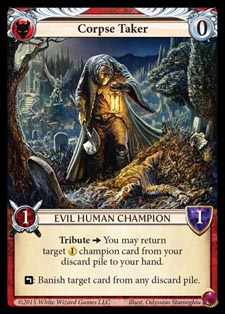
What you must understand next is that most silver cards you play will be a minus to card advantage unless properly used. They aren’t exactly fit for fighting it out with most gold champions, so it’s not as if slapping down a ⓪ and turning it sideways is the same as paying an actual ① for a gold champion. If you can use silvers like Dark Knight to hit someone in the face, you’re now getting some kind of board state change out of your silver. Maybe it’s enough to get you a free gold, like with Fire Shaman above. Maybe it can only break even such as Corpse Taker, which cannot be considered (+1) card advantage due to the fact that its body isn’t capable of furthering the game state. You should consider any ⓪ you draw a pure loss to options and therefore advantage until you can play it right.
However, the magical thing is that once you manufacture such a situation, it often does a paradigm and gives you card advantage or gold advantage. Just with the Dark Knight above, if an opponent blocks it with a gold champion with 5 or less defense, your Dark Knight won’t break but theirs will, netting you a free card and ①. Or if it were to attack twice directly, that’s better than Flame Strike, which is also ①. Because of their opportunities to give major advantages, ⓪ cards are very useful. They just also have the downside of being risky or dead until they can be used effectively. Try to always maximize your silvers without provoking easy silver removal from your opponent (which is indeed the easiest removal). Making your opponent spend gold to remove your silvers is absolutely crucial for getting the maximum use from them. No one likes facing down a 10/10 Breakthrough Wurm Hatchling, and often times it means having to use spot-removal on it.
Extra Turn
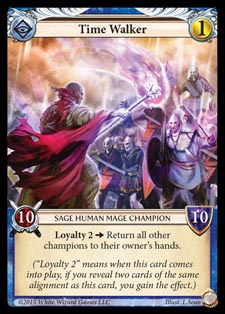
Let’s say you were playing a different board game and you get the “take an extra turn” card. Everyone loves getting that card, right? No one likes the “lose a turn” card because it isn’t any fun. But what can you do on your turn in Epic? Well of course you can attack. But the relevant things to this article are gain ① and draw 1. This is what it’s all leading up to: obviously gaining any kind of advantage in any amount is going to give you the edge in the game, but gaining one of each—that’s an extra turn. Thinking about it, this makes sense. When you’re gaining the resources that you could receive from a given turn, you’re also gaining a turn.
The resources need not necessarily be gained at the same time, back to back, or even in the correct order. You could get three gold advantage, then one card advantage and have one extra turn with two pending. This is a much more abstract concept since you’re clearly gaining something in each of these interims, but it’s worth thinking about how your plays can give you extra turns. If you were, for example, to get every turn in the game and the opponent got none, would you not be guaranteed victory every time? The same goes for starting with 10 gold for you instead of 1, or 15 cards in hand with no limit. Getting these resources slowly over time in the game is very similar, although we’re just going to have to gloss over the rush principle here.
Certainly, this will all come down to play and not assuming your opponent is stupid. Once your opponent makes a mistake, capitalize on it immediately and without hesitation—it should be like breathing to you. This is like finding spare fuel for an engine. But what generates the advantage like an engine is as above: notice, force, and exploit the corner case in the game to gain advantage.
If you liked this article or know anyone who could benefit from it, please share it with your friends and on twitter or facebook!

Leave a comment